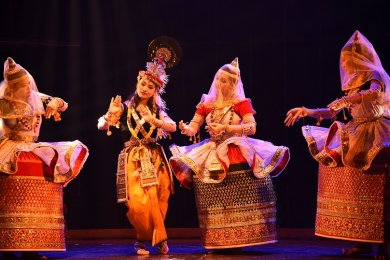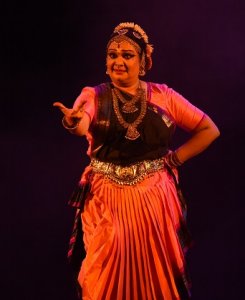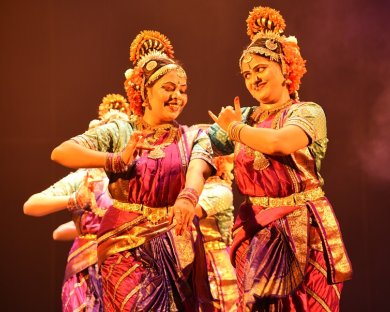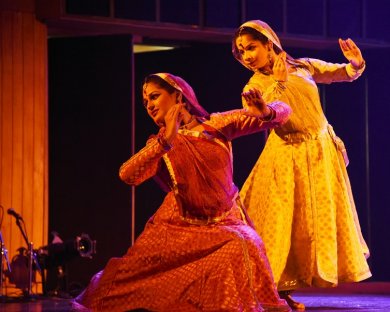
|   |

|   |
An utsav of dance - Shveta Arora e-mail: shwetananoop@gmail.com Pics: Anoop Arora September 25, 2015 Ranjana Gauhar is a leading exponent of Odissi trained under the legendary Guru Mayadhar Raut and Aloka Panikar. Utsav, her dance academy, presented its annual two day festival of Indian dance, Sare Jahan Se Accha, on the 25th and 26th of August 2015 at the IHC in Delhi.  Artistes of JNMDA The first performance on the second day started with Manipuri dance by the artists of Jawaharlal Nehru Manipuri Dance Academy (JNMDA) from Imphal. The production unit of the academy has a rich repertoire of traditional and contemporary works. They presented the Vasant Raas, a composition of Maharaj Bhagyachandra, king of Manipur in the 18th century. The raas is performed on a full moon night of Chaitra (month of the Hindi calendar). In the yearning of gopis, the agonies of the human soul for union with the supreme soul are implied. The Manipuri form of dance has a lot of wavy and graceful movements, with soft leaping movements of the feet. The costumes are also quite beautiful. The group portrayed Krishna playing the flute and Radha approaching, accompanied and served by her sakhis in Vrindavan. When they meet to unite in the beautiful surroundings of a full moon night, with a gentle breeze blowing, they dance and play with colours and pichkaris. Krishna gets miffed so Radha wipes his face to appease him, and then there’s the culmination in a scenic aarti by the sakhis. The entire piece was executed aesthetically by Y. Nerina Devi, G. Chandan Devi, Th. Parul Devi, L. Sunita Devi, O. Debala Devi and Th. Ibemubi Devi.  Bharatanatyam dancer Prathibha Prahlad performed a solo in a collage of three pieces. The primordial sound of the conch of Krishna pleases the entire universe. The birth of Krishna and his play with his mother Yashoda was enacted in ragamalika, talamalika. The first piece started with a shlokam “Sri Krishna sharanam namah.” All of creation - birds, flowers, peacocks, butterflies, cows - all stand amazed listening to the sound of Krishna’s conch. The life and birth of Krishna was depicted from his birth in the prison in Mathura. Devaki is astounded by the four-armed incarnation of the Lord, and pleads with him to come to her as a baby. The abhinaya for the piece was immaculate. The accompanying artistes were - on nattuvangam: Tanjavur R Kesavan, vocals: Sudha Raghuraman, mridangam: M.V. Chandrashekhar and flute: G Raghuraman. In Vrindavan, Krishna is shown playing the flute, wearing the peacock feather. He is the cowherd holding up the Govardhana mountain on his little finger, and dancing on the hood of the serpent Kaliya. The next piece, Krishna ni begane baro, has been visited by many dancers, and they all give their own interpretative spin to it. Prathibha showed Krishna being bathed by his mother. She ties his pitambar on his waist, applies chandan on him. Krishna steals butter and his mother chides him into opening his mouth, seeing the entire universe in it. The abhinaya was excellent for both Krishna and Yashoda. Yashoda begs him to take away that scary vision, and Krishna hugs her lovingly. Prathibha ended the piece with a bhajan. Smita Shastri is a renowned Kuchipudi and Bharatnatyam exponent. Disciples of her Nartan School of Classical Dances performed a padam, a Mira bhajan set to ragam Vrindavana Saranga in adi talam. The dancers as gopis wade through the water in the river when they hear the flute of Krishna - they flee to meet him. The episodes depicted were jhula (playing on swing), raas and Holi. The dancers did energetic nritta with leg lifts. In the Balagopala Tarangam in ragam Mohanam, the poetry had episodes from Krishna Leela Tarangini. The dancers danced on the rims of brass plates, balancing water filled pots on their heads with diyas (lamps) lit on it. Finally, they also held diyas in both their hands. The dancers were Jalpa Joshi, Khyati Vyas, Mahek Khambhata, Bansuri Pandya, Kushani Shah and Het Kapadnekar. Though the rhythm for the piece was fine, the diyas started to get extinguished in the middle of the item, ruining the beauty of the choreography. The spacing between the dancers could have been better managed.  Disciples of Smita Shastri  Disciples of Shama Bhate The next performance was by the disciples of Shama Bhate, who runs the Nad-Roop School of Kathak. The performance portrayed the leelas of Krishna - the Yug Purush, Sankat Mochan and Palanhaar. He is the Jagadguru. The performance began with the shlokam ‘Vasudevasutam devam’. The first leela portrayed was that of Kaliyadaman. The Yamuna and its surroundings were full of life, but as the serpent king inhabits the Yamuna, nature starts wilting. As Krishna vanquishes Kaliya, nature comes alive again. In the next episode, the gopis leave for Mathura to sell their butter. Krishna stops that practice by barring the gopis from leaving and broke their pots full of butter with a stick. And finally, the Kamsavadha. Krishna is taken to Mathura by Akroor on a chariot. Krishna fights and kills the elephant Kuvalaypeed and finally destroys the demon king Kamsa. “The concept has great relevance in today’s times - the buttermilk was exported and the locals were deprived, whereas in the Kaliyadaman leela, we see the tyranny of the serpent king. We are always looking for a saviour who is from amongst us,” said Bhate. The music was composed by Kedar Pandit, and the narration was by Sachin Khedekar. The music was creatively composed - at times, it even featured the piano. The costumes in simple pastels, the lighting and the well-rehearsed dance made for a flawless performance, even though the concept was an oft visited one. The dancers - Ameera Patankar, Vidula Pharate, Avani Gadre, Ragini Nagar, Savani Mohite, Shivani Karmarkar and Ketaki Sathe - showed good technique, agility and energy. The abhinaya, interspersed with storytelling, was well executed. The flow and tempo of the performance did not slacken at any point. Shveta Arora is a blogger based in Delhi. She writes about cultural events in the capital. |